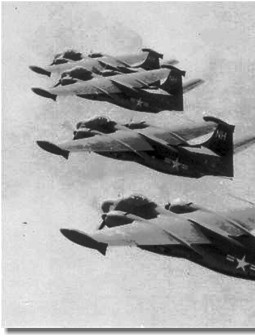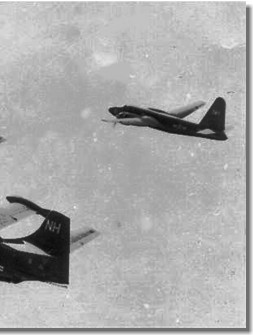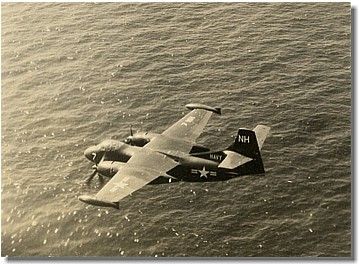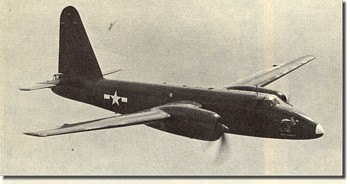|
This is a story about the famous Pratt and Whitney R-3350 engine and a tribute to the flyers who
depend on it and willingly stake their lives on its dependable performance.
The story began on the 21st of July 1952 when our Heavy Attack squadron, VC-7 was ordered to demonstrate
our secondary war-time mission, which was our long-range mining capability. The whole squadron was involved, including
the one P2V-3C Neptune,
which I flew with my crew and a skeleton maintenance team going along to take care of discrepancies in any of the
planes that might need attention at any of our planned refueling stops.
Four AJ-1 Savage, Heavy attack aircraft in company with a
P2V-3C Neptune long range, multi-mission aircraft. This formation of aircraft from VC-7 depicts the beginning of
a long range mining mission soon after they departed from Port Lyautey, French Morocco on 21 July 1952.

  |
In order to demonstrate the long range part of this mission, after we departed Port Lyautey, French
Morocco, we proceeded west to a designated point near the Madeira Islands and then turned around and headed through
the Straits of Gibraltar, past Mallorca in the Baleares Islands, then direct to our target area in the Island of
Sardinia.
In this area we proceeded to carry out our mining mission of planting aerial mines across the entrance
to a specific harbor. To simulate aerial mines, we dropped practice ordnance which gave off a puff of smoke when
it hit the water to mark the point of impact. A photo aircraft from the fleet was on station to record the results
of our mission. As I recall everything went well and the fleet commander was pleased and noted in a message that
he hoped we would never need to employ that tactic at any time in the future.
A photo of an AJ-1 flying low on the water comes next...
One AJ-1 Savage Heavy attack aircraft from Composite Seven,
VC-7, flying low on the water depicts the climax of the squadron's secondary mission, aerial mining.

 |
As we retired from the exercise, we flew south-east some 300 miles to Valletta, on the Island of
Malta, where we had a scheduled visit with the British.
Our time with the British is a story by itself but the key thing is that we enjoyed their hospitality
and spent the night there and then we were off on another day long exercise involving units of the Sixth Fleet
in the central part of the Mediterranean.
Late in the day we landed back again at Malta for a short rest and fuel before making our night-time
journey back to Port Lyautey, French Morocco.
Rather than making this flight together as a squadron, the planes took off at designated intervals to fly back
to Port Lyautey by themselves.
In an operation of this type it was squadron policy for the P2V-3C to take off last because of the
maintenance men that we had with us, plus an emergency bag of spare parts for the AJ's.
I was flying the P2V Neptune, so my flight was the last to depart from Malta - probably around 2100
(9:00pm).
I was about 20 minutes into my trip and was settling down for a normal night fight when my starboard
engine started acting up. I had to shut the engine down and feather the propeller so the blades stand edge-wise
into the wind so that the whole propeller caused the least amount of drag or resistance.
After conducting a three way conference between myself, the skipper, Cdr. Earl J. McConnell, and
our maintenance Officer, Sid Baney, via radio, it was decided that it was "my call" to decide if I wanted
to return to Malta for an engine change, or if I wanted to press on to the west on a single fan to our base in
French, Morocco, where the engine change could be accomplished in our own facilities.
That one good Pratt and Whitney 3350 engine sounded right and the weather was in our favor. After
conferring with the engine specialist and others in the crew that I had aboard, I elected to continue on to the
west.
During that long night we stayed in contact with the planes ahead of us, as we listened closely to
the sound of every stroke of each cylinder and watched intently at the blue glow of its exhaust. The lights of
places along the northern coast of Africa, like Bizerte, Algiers, Oran, and Mallorca on our right moved past us
and fell behind at what seemed like a snail's pace.
One by one we dropped the idea of attempting an emergency landing and pressed on.
Shortly after we turned the corner at "Gib" and headed down the coast toward Port Lyautey,
we began hearing reports about the temperature and dew point being very close together and fog setting in along
the Wadi Sabu River very close to the field at Port Lyautey. The guys ahead of us were getting into the field using
the Ground Control Approach Instrument Landing System, (GCA) so we continued to do our thing and before long we
too were in contact with the GCA unit and were coming down the glide path in the fog.
We had visual contact with the field at about 500 feet and were soon on deck bouncing along on the
rough old runway the Germans built early in WW-II. (The U.S. was building a new runway at that field, but it was
not ready for use at that time.) I even taxied to the parking area on our one good engine and proudly parked our
gallant bird in her usual spot, as if nothing unusual had happened . Cdr. Earl J. McConnell, our skipper, Sid Baney,
our maintenance officer and others were there to greet us and give us a "well done" salute.
The flying time between Malta and Port Lyautey is normally 5.5 to 6.5 hours, but it took me 7.3 hours
to make the trip on the one good engine.
Yes, I have great respect for Pratt and Whitney engines and also for the good judgment of the maintenance
men that were with me. Thank God!!
Below is a photo of the famous "granddad" of my plane, the "Truculent Turtle"
- a P2V that flew non-stop from Perth, Australia to Columbus Ohio. It was a few years earlier but the plane was
basically the same and was equipped with the most reliable Pratt and Whitney engines. There is little doubt in
my mind that that plane and engine combination could have made the whole trip with only one engine.
"Truculent Turtle" Flew non-stop from Perth Australia
to Columbus, Ohio - 29 Sep 1946

Read about this Historic Flight Here
 |
- Hersch Pahl
|